N E W S
2025
“The Play’s the Thing…”: Theater Is Therapy for Armenian Children
2024
Zvartnots Launches New IT Center for Youngsters
Revisiting Gyumri, Armenia’s Cultural Capital
Call for Help Restores Music for Artsakh Children and a Dedicated Music Teacher Twice a Refugee
2023
Children Enjoy Therapy in Theater
Armenians and Germans Join Efforts to Help Artsakh Refugees
Gyumri Conservatory Hosts Premier Harp Concert
2022
New Jazz Quartet in Antwerp Has Roots in Mass.
2021
Ruben Hakhverdyan Trio Plays at My Way Center
My Way Celebrates Creative Inclusion for those with Autism
Bridging Social Distancing for People with Autism
Ceramics Lab for People with Special Needs
A Harp for Gyumri
Ars Musica Brings Grand Concert Harp to Gyumri
2020
Armenians, Autism and the Emirates
2019
“My Way” Center for Autistic Children Celebrates Expansion
Yerevan Music Students Win in Rimini
Artists Launch Creative Fundraising in Istanbul
Young Musicians Prepare for a Better Future
2018
Young Armenian Musicians Delight Audiences in Vienna and Berlin2017
Armenia Visit
Gegashen Concert
Poland Welcomes Promising Armenian Vocalist
2016
Concert at the Gegashen Music School
Visit to Armenia
Sharing the Gift of Music
2015
Wiesbaden Kurhaus Hosts 6th Hessian Foundation Day
Mirak-Weissbach Foundation Featured in Wiesbadener Kurier
Lusine Arakelyan Sings in Italy and Spain
Germans Celebrate Paruyr Sevak
2014
German Tour for Lusine Arakelyan
2013
Mirak-Weissbach Foundation Presented at Lepsius House

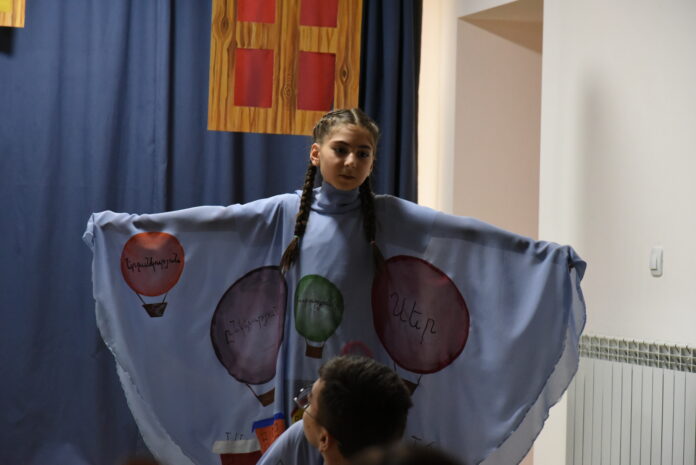
Words on a cloak: happiness, friendship, kindness, love
“The Play’s the Thing…”: Theater Is Therapy for Armenian Children
by Muriel Mirak-Weissbach – JULY 14, 2025
“Many people live in the world; few live in an inner world. It is up to you to decide who should live in your inner world. The world is too big and I am merely a dot in it. But neither I nor the world remain little. The dot grows, the world becomes smaller, and as the dot continues to grow, the world grows as well.
“One day the dot will decide to go home. Of course, I know that my parents, my grandmothers, and grandfathers are impatiently waiting for me. That is ok, let them wait for a while.”
This is not the opening passage to a novel; nor is it the philosophical reflection of an existentialist. It is the candid description by a young boy of how he perceives the world around him and his role in it. Michael Sahakyan, the author, is one of a growing number of Armenian children who take part acting in the Miasin (“Together”) Drama Group of the Center for Children with Learning Disabilities. It is his contribution to the group’s most recent stage production.
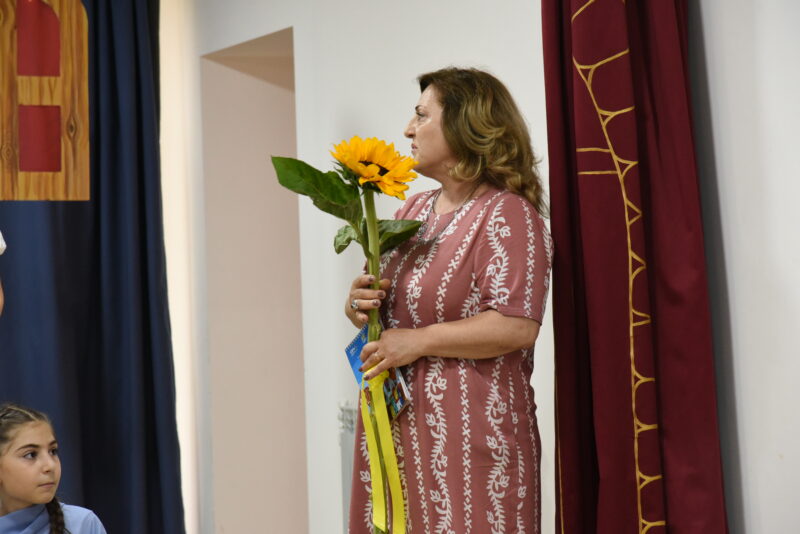
Marine Asatryan
This inclusive theater group is a project founded in March 2022 under the direction of Marine Asatryan, who has extensive experience using the tools of the theater to help children with special needs and to enhance inclusiveness. As a government-regulated institution working with several Armenian ministries and educational institutions, Miasin also enjoys cooperation with international and non-governmental organizations. Its mission is to coordinate pedagogical and psychological assistance to these children, to improve their activities at school and in social relations.
“Stronger Than You Seem,” the first play they performed in October 2022, was inspired by “Winnie the Pooh,” a children’s classic by A. A. Milne. In December 2023, they premiered a production of “Jrashushan Journey” (“The Journey of the Water Lily”) in Yerevan at the Armenian School of Public Education at Kh. Abovyan University (https://fb.watch/pwYTjZa9k9). Co-sponsors of the play were the Fund for Armenian Relief (FAR) and the Mirak-Weissbach Foundation.
Now, in summer 2025, Miasin is breaking new terrain, with a play, “Our World.”
Special Children and Their Special Theater
The Miasin experience, especially in the most recent production, is unique in many ways. The children on the stage are not only acting, but they are the authors of the play, as well as the designers of the costumes. The play deals with children who are obsessed with the search for the meaning of life, who are looking for answers to their questions, their identity, their means of self-expression. What they bring to life on stage reflects the true story of the emotions and feelings that they live with. Each of them brings an individual world to build a bigger world, “Our World.”
Thus, young Michael Sahakyan, who conceived of himself as a dot in the wide world, discussed his self-image and worldview with the other actors and actresses, each sharing an individual experience. Through this exchange process the children articulated thoughts and emotions in words, but then, also in sketches. And the sketches became the draft versions of the costumes that the teachers would design and make. The stage curtain also bears the names of the cast members. In short, it was the children who created the drama. To give an idea of how this process unfolds, consider a few more of their (highly poetical) prose offerings. Actress Sofi Movsisian writes, “In My World,” the following: “People living in many storied buildings are not visible. What I want is to have the peoples’ inner world become visible and trees be always green irrespective of the season.”
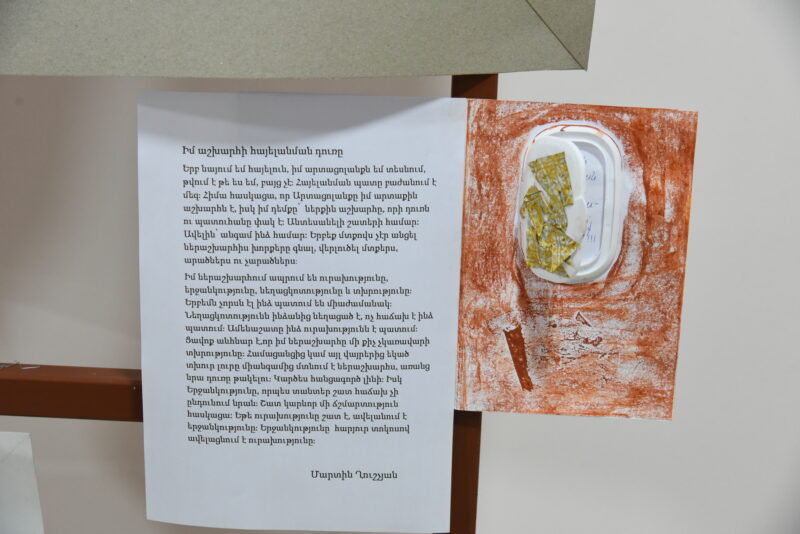
“The Mirror Doors of My World,” text and drawing
Actor Samvel Movsisyan says simply, “I am a Smiling Fish.” Vika Gharibyan’s world “is like piano with white hair and black legs. When I squish the piano, it aches, it cries, it becomes a human being, plays sad melodies. When I touch it tenderly, it becomes a joyful person. The black cat is smiling joyfully.” In “A Brave Tree,” Narek Avetyan writes, “In Narek’s world, the strong and courageous tree once decided to go to the peak of Ararat. Get there and play with the sun. The sun will give love to the tree, the tree will give love to the branches, the branches will give love to the leaves and the trees will return love to the tree. A stork opened its wings and flew up to play with the sun. I helped the tree to bloom. The tree helped Narek overcome the feeling of anxiety, The world becomes filled with sun and everything around turns green. I feel happy that the tree and I helped each other and we made friends.”
Vardan Ghushchyan sees himself as a traffic light: “When somebody hurts me, I put up my red light and ignore him/her. I do everything to have the green light on. There are people in the world whom I do not know. I do not know what kind of people they are, are they kind or evil? But they cross my path. In that case I put on the yellow alarm light.” Whereas Martin Ghushchyan describes the “Mirror Door of My World” thus: “Joy, happiness, grumpiness, and sadness will be in my inner world. Sometime all four embrace me. Grumpiness is insulted, does not visit me frequently. Joy is my frequent guest. Unfortunately, for my inner world, it becomes impossible to bypass sadness. A piece of sad news from the internet or elsewhere immediately penetrates my inner world, without knocking on my inner door. Just like a criminal. But happiness, the real landlord of my world, often does not accept the sadness.
“One truth that I have understood: when there is much happiness, happiness grows, happiness contributes to 100 percent joy.”
Abraham Khojoyan knows what he very much wants to have: “In my inner world belief and the happy moments of my childhood, friendship, endless love, and kindness live side by side. I want very much to overcome challenges while moving from childhood to adolescence. I would love not only to see people on my journey but get know and reveal them.”
These brief, concise utterings capture the essence of a perceived inner world in powerful metaphors that become the subject of images rendered in sketches. Prior to the premiere, guests visited an exhibition of these sketches, drawn by the children to give visual form to their ideas. Ceramics teacher Taguhi Stepanyan then helped to transfer the sketches onto the cloaks that the children donned as costumes on stage. Musical therapist Meline Mnatsakanyan oversaw the musical components and performance in the play. Noteworthy is the fact that every one of the children acting has some level disability: autism, mental disorders, learning problems, and so forth.
Real Life Drama
The play brought all these elements to life on stage. Children dressed in robes bearing the images that identified their stories, and acted out their personal dramas through dialogue and movement. The premiere on July 2 took place at the newly renovated drama therapy hall at the Center for Children with Learning Disabilities. The renovation was done by FAR with financial support from several US-based organizations including John Mirak Family Foundation. Drama group leader Marine Asatryan, who is also the director, introduced the play, then the curtain parted and the play was on.
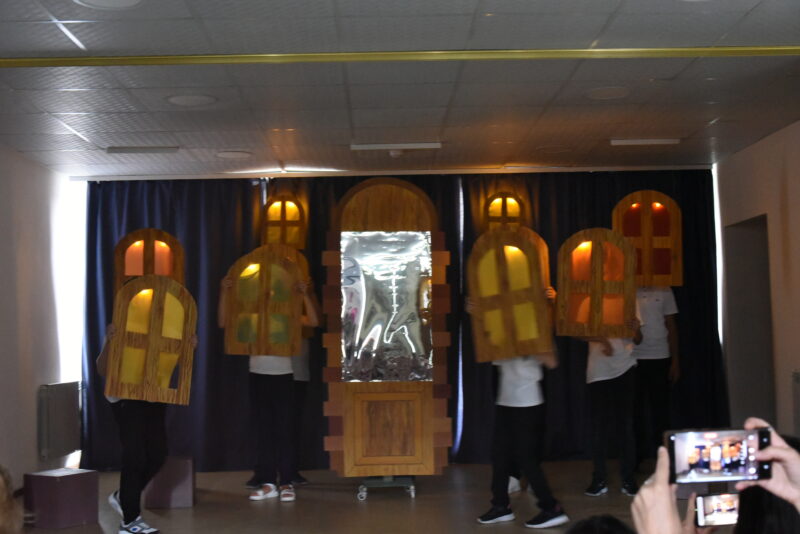
Looking through windows that stand between their world and our world
Several children appear on stage holding up in front of them props that represent windows and seem to be trying to look through them. These are the windows that stand between their world and our world. Perhaps this is the image that Sofi Movsisian had in mind when she wrote about people living in buildings with many floors, not visible to the outside world.
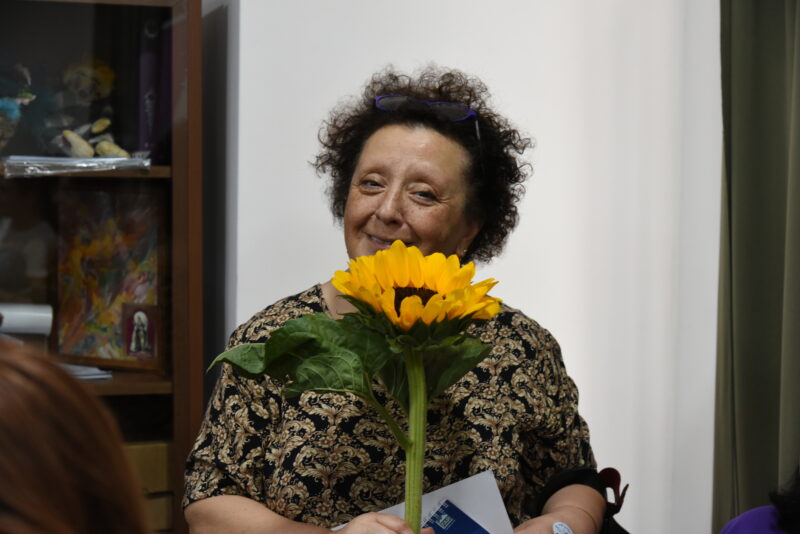
Margarit Piliposyan
In telling their stories, the children delivered their lines with vigor and expression. Margarit Piliposyan, who is FAR’s Executive Director of Operations, described the premiere as “a wonderful fusion of positivity, emotions, openness, love, inclusivity radiating from the stage to all of us in the hall.” She was “able to observe the improvements the children had made compared to their former presentations (better articulation, less shyness, improved self-confidence).” Of course, the most important feature of the performance was the successful execution of its basic purpose: to portray, — or, better, actualize — through drama inclusion and participation as a social process. “Most importantly,” she commented, “the entire process, as the director explained, was participatory – the children came up with their scenarios, did sketches to describe their world, then used the sketches for the clothing made for them.” And the entire journey from conception to realization was a result of teamwork: “drama therapist/director, ceramics/applied arts teacher, music therapist, the children, their siblings, and parents. Isn’t it wonderful?” Piliposyan was enthusiastic: “There is room for everyone in our world! was the message we got from the excellent work the team did!”
Following their summer vacation, the children in the drama group plan to take their play on tour, as they had done with the previous productions, bringing their message to other children in the country.
A video of the play is found below.
